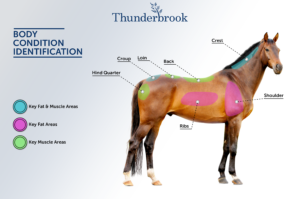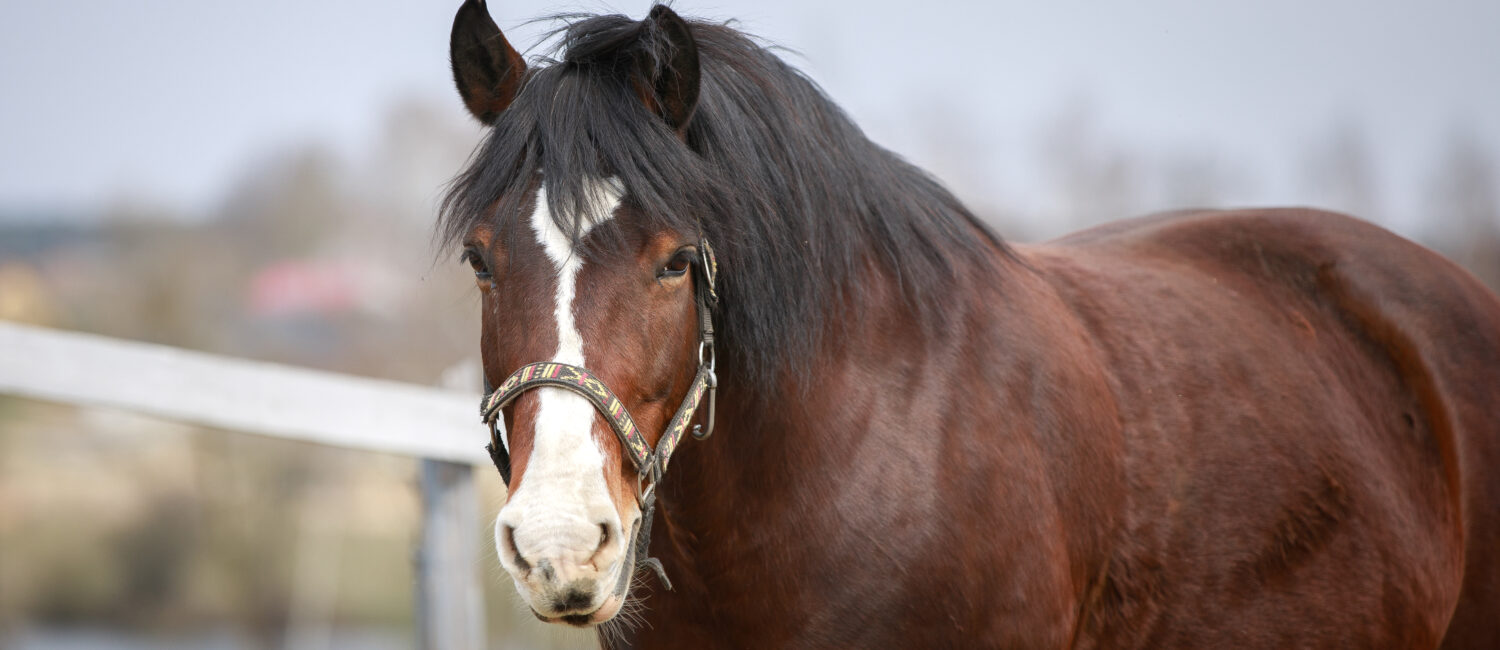Is the weight of your horse too fat or too thin?
Maintaining your horse within the ideal weight range is crucial for its health. Being overweight increases the risk of conditions such as laminitis, diabetes, or Equine Metabolic Syndrome (EMS). Conversely, being underweight can lead to deficiencies and digestive problems. Begin by assessing your horse’s current condition.
To determine your horse’s weight, you can use special scales for large animals (available from your vet, for example) or vehicle scales, such as those provided by co-operatives. If scales are not accessible, special measuring tapes can help estimate your horse’s weight.
However, weight is not the only decisive factor, as kilos alone do not always provide sufficient information about your horse’s physical condition. Let’s also take a look at the body fat values, which are determined using the Body Condition Score (BCS) or fat score.
Determine the fat index with the body condition score
With the Body Condition Score, you determine the ratio of fat tissue to fat-free mass and assign a score between 1 and 9, where 1 stands for “very lean” and 9 for “very obese”. You only assess the amount of stored fat in 6 different areas, but not the condition of the muscle mass or the coat. This system is applicable to all types of horses, from unridden ponies to event horses.
A score of 5 indicates a normal-weight horse. Horses naturally lose weight in winter and gain it back in spring when being back on nutritious meadows, so slight fluctuations are normal.
How to Perform Body Condition Scoring:
Carrying out the body condition scoring is very simple. To evaluate the fat index, you need to feel the fat layer on your horse in 6 different areas.

Feel the areas of the neck, withers, shoulder, back, ribs and croup and then give your score between 1 and 9 for each area. Half points are also permitted in the assessment. The fat pads are soft and “flabby” if the horse is overweight, while muscles feel firm, and bones offer direct resistance. Add up the six scores and calculate the average to get the Body Condition Score.
Tip: Repeat the scoring three times and take the average for a more accurate result. Be honest with your assessment for the best outcome.
Assessing the six areas:
- Neck and Withers: Feel the neck at the mane ridge. Does it wobble slightly (fat) or feel firm (muscle)? Check if it thickens significantly from the back of the head to the withers, which should not be bony or surrounded by fat.
- Shoulder: Run your hand from the neck to the shoulder. Fat accumulation in front of the shoulder blade will make your hand glide without resistance.
- Back: Place your hand on the back. Ideally, it should form an arch over the spine. Excess weight makes your hand flat due to fatty tissue buildup on both sides.
- Ribs: Feel the sides of your horse. The ribs should be easily felt.
- Croup: Look at the croup from behind. It should have rounded hind cheeks.
Note: Always assess the individual conformation of your horse. Certain pony breeds, such as natives or draft horses often store excess fat in “pads” around their shoulders and crest. So pay attention to this and take this into account in your assessment. Horses also don’t store too much fat on the underbelly, so don’t use this area to assess weight.
The scale of the Body Condition Score
1 = Poor / Extremely thin
If the body condition score is 1, a horse is extremely lean or severely underweight. You can recognise this by a very pronounced bone structure on the neck, shoulder and withers, which you can clearly feel and see. The spinous processes and ribs are also clearly recognisable. If a horse is extremely lean, you will not be able to feel any fatty tissue and the croup will be visible under the skin.
2 = Very thin
Even in a very lean horse, the bones in the neck, shoulders and withers can be clearly felt. The spinous processes and the croup can also be felt. In addition, the ribs are clearly visible to the naked eye.
3 = Thin
A horse is considered lean if the bones in the neck, shoulders and withers are prominent but the bone structure is not clearly distinguishable. The spinous processes on the back can no longer be felt directly due to the first, light fat pads. The croup is no longer recognisable to the naked eye, but can be felt quickly. You can still see and feel the ribs.
4 = Moderately thin
In a slender horse, the neck, shoulders and withers are not noticeably thin or bony. The spine on the back is recognisable by a slight groove, but the spinous processes are no longer visible. Depending on the horse’s build, the croup may be more or less prominent. You can feel a little fatty tissue in all 6 places. You can still recognise and feel the horse’s ribs a little under the skin.
5 = Normal weight / Moderate
A body condition score of 5 indicates a horse of normal weight. The neck and shoulders form a smooth transition. You can recognise the withers, but they are slightly rounded due to small fat pads. When you feel the croup, it feels slightly spongy. You can still feel the ribs, but they are no longer recognisable to the naked eye.
6 = Slightly overweight
The first fat pads are visible around the neck, shoulders and on the sides of the withers. You can feel slight thickening along the spine of a slightly overweight horse. The fat tissue makes the croup feel soft. You can still feel the ribs, but the first fatty deposits, which feel spongy and soft, are possible.
7 = Overweight
In an overweight horse, the fat pads settle at the crest of the neck, the withers and behind the shoulders. You can recognise and feel the fatty tissue. You can also feel additional fatty tissue on the spine. The fatty tissue on the croup feels soft. Fat pads are deposited on and between the ribs.
8 = Obese
The fat pads in an obese horse are very clearly visible in all 6 areas. You can quickly recognise a thickened neck. Fat pads are deposited at the withers and in the area directly behind the shoulder. The thickening of the spine is pronounced and the croup is also filled with fatty tissue. It is difficult or impossible to feel the ribs on an obese horse.
9 = Extremely obese
A body condition score of 9 indicates an extremely obese horse with lots of visible fat deposits. A clear ridge forms on the neck. There is an excessive amount of fatty tissue on the withers and directly behind the shoulder and on the croup, which you can see and feel. These fat deposits all over the body can even cause the horse’s hind paws to rub against each other. In addition, the flanks are no longer separated and there are also fat pads on the ribs so that you can no longer see or feel them.
As you can see, the body condition score is not that difficult to determine. You can quickly determine your horse’s fat index and take appropriate measures. Always keep an eye on your horse’s well-being and current situation. A body condition score of 5 may be the optimal score for many horses – but if your horse is a true athlete and competes, its ideal fat index may be closer to 4.
Tip: When your horse is losing weight, bear in mind that its nutritional requirements depend on many different factors. Leisure horses often cover their daily requirement of nutrients, vitamins and minerals with high-quality roughage in combination with a good balancer. Adding concentrated feed would only result in extra kilos.
Is your horse too thin and has a low body condition score?
Then you need to take action too. High-quality forage and a good quality balanced feed can form the basis of a healthy horse diet. Ideally, forage should be available to your horse around the clock. To help your thin horse gain weight, it is also a good idea to add a protein-rich concentrates like Thunderbrook Micronized Linseed.

